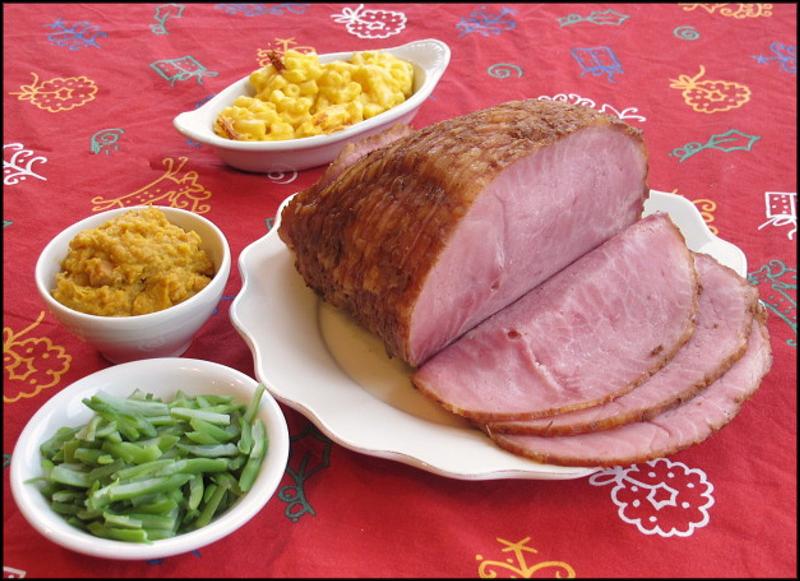Christmas ham is an easy, flavorful alternative to turkey
Why is ham so popular as a main course for Christmas dinner? One reason might be that we’re tired of turkey – roasted on Thanksgiving and then appearing in an endless array of leftover configurations. Another reason could be that we fall victim to the grocery stores’ abundant supply of gaily wrapped hams offered at sale prices. Or, it could be that the meat is already cooked and the reheating process can occur in the background while we open gifts.
According to food historians, the tradition likely evolved from pagan times in Scandinavia, where yuletide celebrations honored Freyr, the Norse god of the harvest, prosperity and fair weather. The most popular food for this feast and others in many early Germanic traditions was wild boar, a logical predecessor to the baked ham that has become associated with Christmas celebrations.
As with most foods, the name “ham” can refer to several different things, from luncheon meat to an untalented stand-up comic. Here, we are referring to the meaty upper portion of the rear leg of a pig. What is called a “whole” ham is the entire leg that can weigh up to 20 pounds and serve more than 30 people. Once we know where the meat comes from, we can learn about the types of ham.
Fresh ham is just that, simply butchered, uncured, and with the same texture and color as an uncooked pork roast or tenderloin. These must be cooked before serving, as you would a pork butt. Cured (and often smoked) ham is either brined and called “city” ham or cured with a dry rub, hung to dry and called “country” ham. Do not even consider purchasing a canned ham, as these are made from compressed scraps and plumped with saline solution.
When purchasing a half-ham, you can select either the lower or shank end, which has a leaner texture and the traditional profile with a single long bone. The top or butt end of the leg is closer to the hip with fattier, richer meat. The shank is easier to carve, while the butt has a T-shaped bone that makes carving tricky. A bone-in ham will give you more flavor, and the added benefit of a bone to make stews and soups.
Another option is a pre-cooked and pre-sliced ham, which solves all the serving challenges. Some are “spiral-sliced,” while other are simply labeled “pre-sliced.” You should check the label when you select a pre-cooked ham. Look for those with ham and little else beyond “natural juices” on the ingredient list. Those described as “water added” will often be bland in flavor and spongy in texture. You will pay more for a better-quality product, but the taste will make it a worthwhile investment.
If you’ve opted for a pre-cooked ham, you will want to be careful in how you reheat it, as there’s ample opportunity to dry out the meat. Figure out how long it will take to heat the ham, assuming 15 minutes per pound at 300 or 325 F. Take the ham out of the refrigerator at least two hours before you plan to start cooking, so it can reach room temperature (leaving it still in its wrapping).
For pre-sliced hams, make sure they are placed in a roasting pan with about one-half cup of liquid (wine, broth or water) and covered tightly in aluminum foil — these steps will prevent the ham from becoming dry. If you choose to glaze your ham, wait until the final few minutes, so it doesn’t burn. I like coating ham with glaze and setting it under the broiler for just a minute or so to brown the top. Allow it to rest (covered with foil) before serving.
I’ve included a recipe for roasting a ham that has not been already pre-cooked, as well as two different glazes that might be more interesting than the packet that often comes with a pre-cooked ham. In the photo, our pre-sliced ham is accompanied by macaroni and cheese, green beans, and mashed sweet potatoes. Happy Holidays!
Baked Ham
6- to 8-lb. bone-in ham
1 T whole cloves
2/3 C dry white wine
Preheat oven to 325 F. Place ham in a roasting pan, cut side down. Cut fat layer into a diamond pattern, slicing through fat but not into meat. Insert cloves in each X of the grid. Pour wine over ham and cover tightly with aluminum foil. Bake, covered, for one hour, then remove foil and spread with glaze. Continue baking until meat thermometer registers 135 F, about 15 minutes per pound. If desired, place ham under the broiler to crisp slightly before removing from oven. Allow to rest under a foil tent for 20 minutes before slicing.
Honey Mustard Glaze
3 T grainy mustard
1 T honey
2 T brown sugar
Whisk together ingredients and brush onto ham after one hour of baking.
Thyme Glaze
2 T fresh thyme leaves
1/4 C apple cider vinegar
3 T honey
1 T brown sugar
3 T melted butter
1/2 t white pepper
Whisk together ingredients and brush onto ham after one hour of baking.





















































